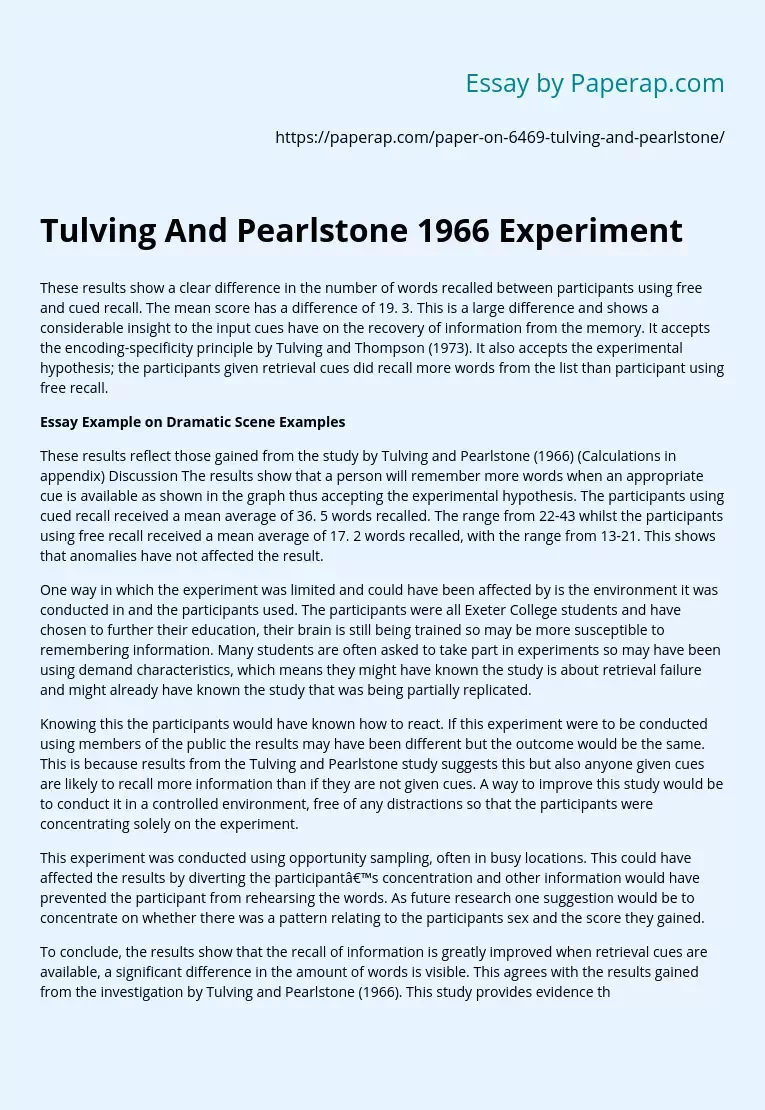Tulving And Pearlstone 1966 Experiment
These results show a clear difference in the number of words recalled between participants using free and cued recall. The mean score has a difference of 19. 3. This is a large difference and shows a considerable insight to the input cues have on the recovery of information from the memory. It accepts the encoding-specificity principle by Tulving and Thompson (1973). It also accepts the experimental hypothesis; the participants given retrieval cues did recall more words from the list than participant using free recall.
Essay Example on Dramatic Scene Examples
These results reflect those gained from the study by Tulving and Pearlstone (1966) (Calculations in appendix) Discussion The results show that a person will remember more words when an appropriate cue is available as shown in the graph thus accepting the experimental hypothesis. The participants using cued recall received a mean average of 36. 5 words recalled. The range from 22-43 whilst the participants using free recall received a mean average of 17. 2 words recalled, with the range from 13-21.
This shows that anomalies have not affected the result.
One way in which the experiment was limited and could have been affected by is the environment it was conducted in and the participants used. The participants were all Exeter College students and have chosen to further their education, their brain is still being trained so may be more susceptible to remembering information. Many students are often asked to take part in experiments so may have been using demand characteristics, which means they might have known the study is about retrieval failure and might already have known the study that was being partially replicated.
Knowing this the participants would have known how to react. If this experiment were to be conducted using members of the public the results may have been different but the outcome would be the same. This is because results from the Tulving and Pearlstone study suggests this but also anyone given cues are likely to recall more information than if they are not given cues. A way to improve this study would be to conduct it in a controlled environment, free of any distractions so that the participants were concentrating solely on the experiment.
This experiment was conducted using opportunity sampling, often in busy locations. This could have affected the results by diverting the participant’s concentration and other information would have prevented the participant from rehearsing the words. As future research one suggestion would be to concentrate on whether there was a pattern relating to the participants sex and the score they gained.
To conclude, the results show that the recall of information is greatly improved when retrieval cues are available, a significant difference in the amount of words is visible. This agrees with the results gained from the investigation by Tulving and Pearlstone (1966). This study provides evidence that the free recall group knew more than they could recall, this can be stated as both groups experienced the same conditions during the learning phase and yet the cued recall group could recall far more words.
Tulving And Pearlstone 1966 Experiment. (2019, Nov 27). Retrieved from https://paperap.com/paper-on-6469-tulving-and-pearlstone/

